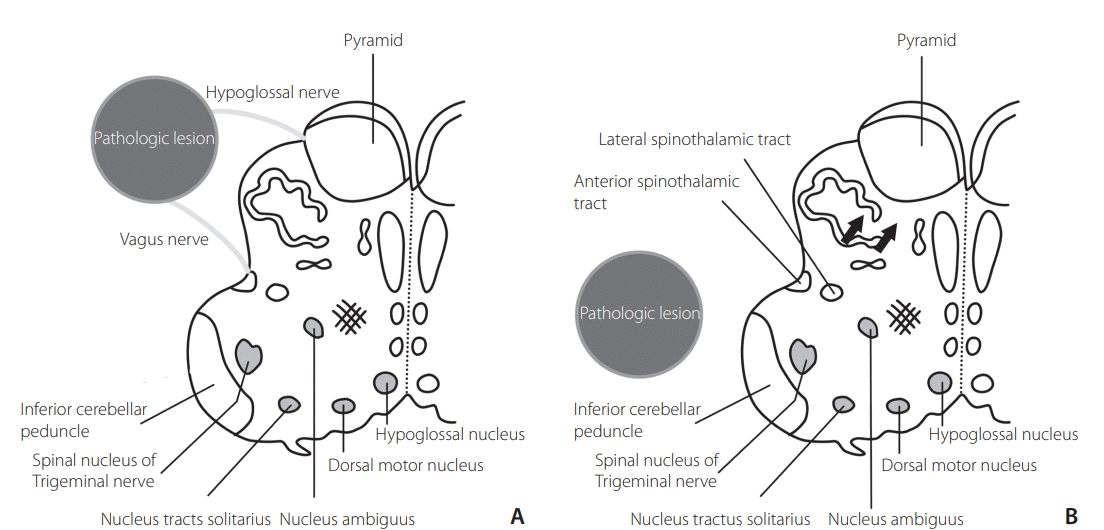1. Tapia AG. [A new syndrome; few cases of hemiplegia larynx and language with or without sterone-crypto-palsy. Mastoid and trapeze]. Arch Int Laryngol Otol Rhinol. 1906; 22:780–785. French.
2. Al-Sihan M Jr, Schumacher M, Löhle E. Tapia syndrome caused by a vertebral artery dissection. Ear Nose Throat J. 2011; 90:313–314.

3. Andrioli G, Rigobello L, Mingrino S, Toso V. Tapia’s syndrome caused by a neurofibroma of the hypoglossal and vagus nerves: case report. J Neurosurg. 1980; 52:730–732.
4. de Freitas MR, Nascimento OJ, Chimelli L. Tapia’s syndrome caused by Paracoccidioidis brasiliensis. J Neurol Sci. 1991; 103:179–181.

5. Shimohata T, Nakano R, Sato S, Tsuji S. [A patient with aneurysm of extracranial internal carotid artery presenting lower cranial polyneuropathy similar to Tapia’s syndrome]. Rinsho Shinkeigaku. 1994; 34:707–711. Japanese.
6. Boisseau N, Rabarijaona H, Grimaud D, Raucoules-Aimé M. Tapia’s syndrome following shoulder surgery. Br J Anaesth. 2002; 88:869–870.

7. Krasnianski M, Neudecker S, Schlüter A, Krause U, Winterholler M. Central Tapia’s syndrome (“matador’s disease”) caused by metastatic hemangiosarcoma. Neurology. 2003; 61:868–869.

8. Sotiriou K, Balanika M, Anagnostopoulou S, Gomatos C, Karakitsos D, Saranteas T. Postoperative airway obstruction due to Tapia’s syndrome after coronary bypass grafting surgery. Eur J Anaesthesiol. 2007; 24:378–379.

9. Tesei F, Poveda LM, Strali W, Tosi L, Magnani G, Farneti G. Unilateral laryngeal and hypoglossal paralysis (Tapia’s syndrome) following rhinoplasty in general anaesthesia: case report and review of the literature. Acta Otorhinolaryngol Ital. 2006; 26:219–221.
10. Chun DH, Kim ST, Jeong YG, Jeong HW. High-resolution magnetic resonance imaging of intracranial vertebral artery dissecting aneurysm for planning of endovascular treatment. J Korean Neurosurg Soc. 2015; 58:155–158.

11. O’kelly CJ, Krings T, Fiorella D, Marotta TR. A novel grading scale for the angiographic assessment of intracranial aneurysms treated using flow diverting stents. Interv Neuroradiol. 2010; 16:133–137.

12. Kai Y, Nishi T, Watanabe M, Morioka M, Hirano T, Yano S, et al. Strategy for treating unruptured vertebral artery dissecting aneurysms. Neurosurgery. 2011; 69:1085–1091; discussion 1091-1092.

13. Kobayashi N, Murayama Y, Yuki I, Ishibashi T, Ebara M, Arakawa H, et al. Natural course of dissecting vertebrobasilar artery aneurysms without stroke. AJNR Am J Neuroradiol. 2014; 35:1371–1375.

14. Kassis SZ, Jouanneau E, Tahon FB, Salkine F, Perrin G, Turjman F. Recovery of third nerve palsy after endovascular treatment of posterior communicating artery aneurysms. World Neurosurg. 2010; 73:11–16; discussion e2.

15. Ko JH, Kim YJ. Oculomotor nerve palsy caused by posterior communicating artery aneurysm: evaluation of symptoms after endovascular treatment. Interv Neuroradiol. 2011; 17:415–419.

16. Cho DY, Kim BS, Choi JH, Park YK, Shin YS. The fate of unruptured intracranial vertebrobasilar dissecting aneurysm with brain stem compression according to different treatment modalities. AJNR Am J Neuroradiol. 2019; 40:1924–1931.







 PDF
PDF Citation
Citation Print
Print



 XML Download
XML Download